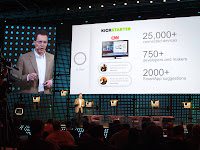after having mastered the social graph (aka facebook) and the knowledge graph (aka google knowledge graph), it is now the time to tackle the "physical graph", also known as the "internet of things" (IoT). this was the mantra of the 2012 paris edition of leweb. and while more and more consumer products appear, behind the curtains, the "battle of the middleware" just started.
while the concept of IoT is around since 1999, only now smart consumer products appear. be it clever thermostats (
nest), emotional email writing interfaces (
muse), seemingly intelligent connected toys (
ubooly) or the omnipresent activity monitors (
fitbit,
fuel). and they are just the beginning of a wave, which should reach it´s full extend in 10 years according to
tony fadell, founder of nest.
there is something, which lies under the surface of those equally interesting tools and toys though. how do all those physicals devices get connected and how are the data managed in a meaningful way for the user? when exploring this, one discovers a "battle of the middlewares".

whatever new trend the it-sector is running after there is one common phenomena to be observed - and IoT is no exception to this. everyone like´s to be "the one" in the middle - the one to rule them all. thus not only enabling a multitude of services with reduced implementation time but also harvesting through system lock-in in the long run.
at leweb alone three middleware solutions for IoT were introduced.
smarthings, an ambitious kickstarter project trying to cover the whole stack, from development platform to dedicated hardware.
sense, from the founder of the wonderful but not so profitable
nabaztag, more focusing on the data integration side. and finally
ninja blocks, a startup looking more at the hardware side with a open source approach.
but that´s not all yet. there are more folks on the battleground than those three:
and if the middleware multiverse would not be enough, big corporates like
ibm enter the battle and throw the messaging queuing telemetry transport protocol "
MQTT", the equivalent of the http protocol for objects, into the game.
so what todo with all that?
well, when setting of to tackle a physical graph project, one might consider the following three things. first, lookout if there is a softwarestack already existing that allows a faster implementation time of one´s own project.

second, all those projects are a actually a "map" where to find the right talent to implement one´s own project.
third and finally given the time frame until mass adoption for IoT products, financial investments to create real physical goods, the additional costs & time for pivoting requires even more focusing on the minimal viable product in combination with alternative investment approaches like crowdfunding. but that´s another topic to be covered.
 whatever new trend the it-sector is running after there is one common phenomena to be observed - and IoT is no exception to this. everyone like´s to be "the one" in the middle - the one to rule them all. thus not only enabling a multitude of services with reduced implementation time but also harvesting through system lock-in in the long run.
whatever new trend the it-sector is running after there is one common phenomena to be observed - and IoT is no exception to this. everyone like´s to be "the one" in the middle - the one to rule them all. thus not only enabling a multitude of services with reduced implementation time but also harvesting through system lock-in in the long run.




